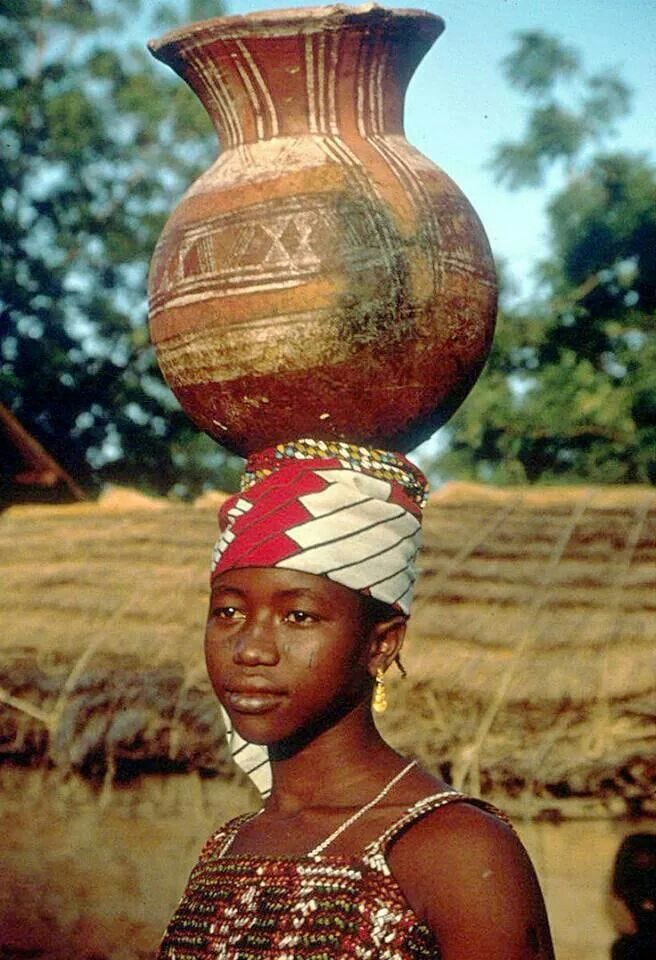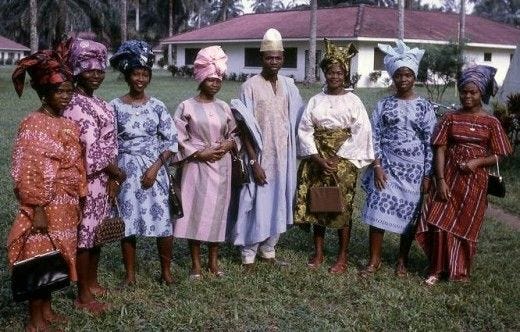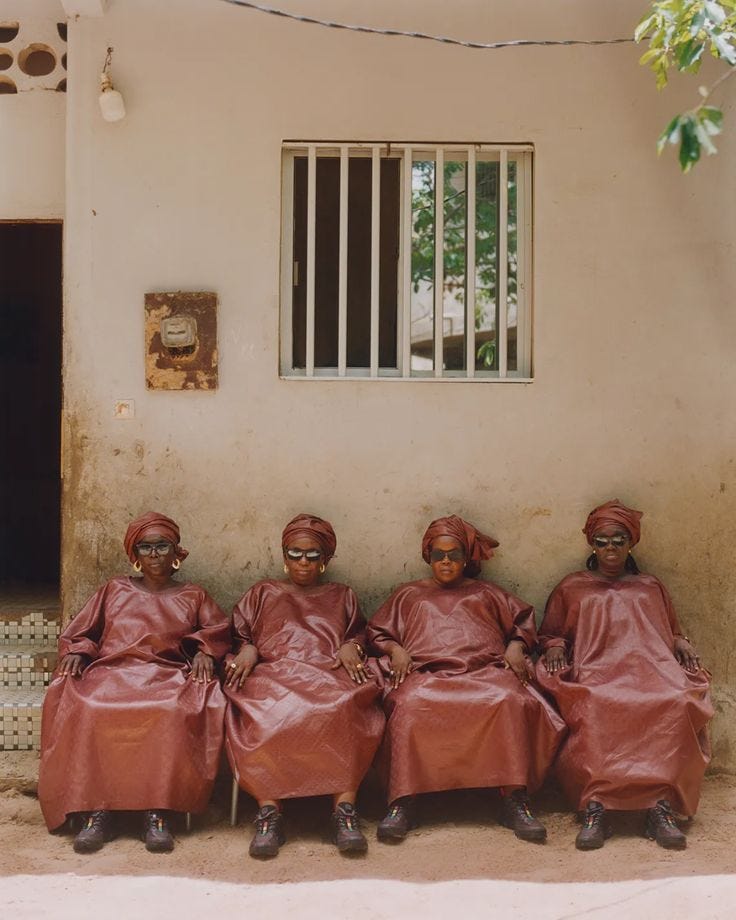put it on my head
Cloth that does more than cover, it carries
Growing up my mother and grandmother always tied scarves around their heads and waists—to do work around the house, to run errands, to go to sleep, and to go to special events. For Cameroonian women, these patterned, colorful textiles serve both function and fashion for all sectors of life. Stacks of these fabrics lived in the closet piled tall in different sizes, materials, and designs. No two were alike, each was distinct in its color combinations, patterns, and visual texture. Most head ties had a matching wrapper, a long stretch of cloth draped around the waist or body resembling a skirt. The wrapper is a garment, that is worn both day to day and in more formal settings, and is often transformed to be used to help carry items and even children on their heads and backs. As a baby and young child, my mother would use a wrapper to tie and carry me on her back, a practice we referred to as ‘ba ba’. It allows mothers to carry their young and still have the freedom and flexibility in front to use their arms and hands. Any load too heavy to carry in the arms would be placed on the head and cushioned by a head tie or wrapper. The women in my family would tell tales of carrying gallons of water and baskets of produce across the village balanced on their heads, a practice my mother did not abandon when she came to the US, still opting to lug loads around in the way she knew best. The act of head-carrying shows the endurance and ingenuity of the women who practice it, as well as their ability and willingness to balance so many roles and tasks at once.
For centuries in African cultures, the head tie has been a multifaceted piece of clothing, used to cover up at home, carry water and items on their heads, carry children on their backs, adorn in bold styles at gatherings and major events, and more. It’s a piece of clothing that truly exemplifies what fashion is—an intersection of art, beauty, community, and function—showcasing the dynamism of the women who wear them. These pieces of cloth do so much more than just cover they carry—life, responsibility, memory, and meaning.
Head ties are more than accessories; they are symbols of beauty and honor. Across cultures and religions, hair carries great significance and is seen as something to protect. Biblically hair represents strength and to cover and care for one's hair is an act of spiritual protection and regard. In the Bible, Samson’s strength was famously tied to his long hair. His hair was a symbol of his divine covenant and unwavering faith in God. When his hair was cut, it represented a break in this sacred bond, and he consequently lost his formidable strength. This story illustrates the belief that hair is not just a physical attribute but an extension of one's spiritual essence. A head covering serves the purpose of protecting the beauty and strength our hair represents.
I used to wear my head tie to hide my hair, often because I felt that what lay underneath—fuzzy braids or tangled locs—was less than beautiful and needed to be concealed. As I reflect on the true significance of a head tie, I realize that it’s not about hiding, it’s about showing honor and respect towards one’s crown, allowing the adornment that covers it to reflect the inherent beauty and value of what it conceals.
A head tie is much more than a cover. Whether we wear it to sleep, while running errands, or at a grand ceremony, it serves as a statement that the hair beneath it is as valuable as the fabric that adorns it. It’s a way of acknowledging that what’s hidden is precious and worthy of reverence. The head tie becomes a symbol of the respect we have for our own beauty and the intrinsic worth of our natural self.
In covering our hair with these bold, expressive head ties, we honor the beauty that exists underneath. It allows the cloth to mirror and elevate the inherent worth of what it covers, transforming an act of covering into one of celebration and esteem.
In Nigerian culture, women adorn themselves with elaborate scarves known as Gele to signify beauty, maturity, and pride in both their personal identity and cultural heritage. These intricately wrapped headpieces are far more than decorative; they are symbols of a woman’s confidence, femininity, and elegance.
The Gele is an art form in itself, showcasing a woman’s skill in draping and styling the scarf to complement her outfit and personal style. The size, material, and patterns of the Gele can reveal much about a woman’s status, tribe, and background, making each Gele not only a statement of individual grace but also a reflection of cultural pride.
Wearing a Gele is a celebration of the beauty and strength it represents. It’s an elegant form of expression that both enhances and protects a woman’s beauty. The Gele adds a layer of sophistication while safeguarding the wearer’s personal and cultural essence. In this way, the Gele does not merely cover but also magnifies and honors the beauty it frames, embodying both a shield and a showcase of the wearer’s rich heritage and self-assurance.
Also represented in these textiles is a sense of community and unity. A prominent example of this is the practice of wearing aso-ebi, a tradition where families and close friends don matching attire made from the same material, color, and pattern for significant events. This coordinated approach to dressing highlights the importance of connectedness and shared identity.
Whether celebrating marriage or mourning death, connectedness is a priority in it all. The uniformity in fabric and design underscores the bond among family members and friends, marking their collective presence and support for one another.
During such gatherings, the coordinated attire acts as a physical manifestation of the family unit, reinforcing a sense of belonging and mutual support. It visually communicates the strength of their connections and the significance of their shared experiences. The use of matching fabrics becomes more than just a fashion statement; it is a profound expression of togetherness, symbolizing that despite the individual differences within the family, their unity is both celebrated and cherished.
To be a woman is to embody a harmonious blend of strength, grace, beauty, and honor. It means carrying ourselves with a sense of purpose and style, nurturing those around us, leading with wisdom, and engaging in meaningful community. These are not merely roles we fulfill; they are integral to our very essence.
The fabric we choose to wear speaks volumes about who we are. It communicates our identity, our origins, our beliefs, and our responsibilities. A life story can be told through the threads, weaving together the experiences and values that define us.
As women, we navigate a multitude of roles and responsibilities with resilience and poise. Even when our hands are full and life demands more, and more from us, we simply put it on our heads, embracing the balancing act, and doing so with style.






Beautiful writing!